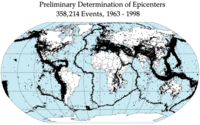
Photo from wikipedia
Coseismic fault displacements in large earthquakes have caused significant damage to structures and lifelines on and near fault lines. Coseismic displacements represent a real threat, especially to distributed infrastructure systems.… Click to show full abstract
Coseismic fault displacements in large earthquakes have caused significant damage to structures and lifelines on and near fault lines. Coseismic displacements represent a real threat, especially to distributed infrastructure systems. For infrastructure systems that can not avoid active faults, engineering displacement demands are defined using probabilistic fault-displacement hazard analyses (PFDHA). However, PFDHA models are sparse and poorly constrained partly due to the scarcity of detailed fault-displacement observations. Advancements in dynamic rupture simulation methods make them an attractive approach to address this important issue. Because fault displacements can be simulated for various geologic conditions as constrained by current knowledge about earthquake processes, they can be used to supplement the observation datasets. In addition to providing on-fault displacements, when used with appropriate constitutive models for the bulk medium, they can capture off-fault distributed inelastic deformations as well. For viable extrapolation, simulations must first be validated against data. In this article, we summarize the calibration and validation of the dynamic rupture model against the observations of the well-documented 1992 Landers earthquake. We defined a preferred model that reproduces several first-order fault-displacement metrics such as the on-fault partition of the total displacement, the mean fault-zone width, and the location of the peak displacement. Simulated ground motions consistent with the observations ensure that all physics important to modeling have been properly parameterized. For the extrapolation, we generated a suite of dynamic rupture models to quantify expected fault-displacement metrics, their intercorrelations, and magnitude dependencies, which are in part supported by the Landers and other recent earthquakes. Our validation and extrapolation exercise paves the way for using dynamic rupture modeling to quantitatively address fault-displacement hazard on a broader scale. The results are promising and are expected to be useful to inform PFDHA model development.
Journal Title: Bulletin of the Seismological Society of America
Year Published: 2021
Link to full text (if available)
Share on Social Media: Sign Up to like & get
recommendations!